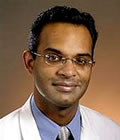|
Angioplasty
from the Wrist: Interest Growing But Lack of Training Limits
Spread in U.S.
Practitioners of the
Transradial Approach Agree that More Exposure to the Technique
is Needed at National Cardiology Meetings
|
 |
April 17, 2009 -- The
transradial approach to catheter-based procedures, where the
radial artery in the wrist is used for angioplasty
and
stents, is
in its infancy
in the United
States, even though it is widely utilized in the rest of the world.
In
the past two years a number of large studies have been published
showing a significant reduction in bleeding complications and
mortality with the wrist approach, as compared to the standard
access
site used in the U.S. -- the femoral (or groin) artery. Moreover,
patients are able to sit
up and walk almost immediately after the wrist procedure, increasing
not only their comfort and recovery time, but the cost-effectiveness
of the procedure, a major issue in today's healthcare environment.
The question raised by this information is
why the use of radial access in the United States is in the low
single digits, when it is the default access site for many cardiologists
in other countries?
Just one example of this disparity could
be seen
in
an important study
at
last month's
ACC.09
meeting.
Dr
Giles
Montalescot
of Paris
presented
results from the ABOARD study of 352 non-ST-elevation ACS (NSTE-ACS)
patients -- speed of treatment was being studied,
but an interesting side-fact was that the transradial
approach was
used in 84% of this very high risk population. Dr. Montalescot
told Angioplasty.Org that the radial approach is his default access
and that he is able
to use it in virtually all of his cases.

A sea of
poster presentations
at a national
cardiology meeting |
|
U.S. cardiologists who
practice the radial approach have identified
lack of training opportunities as a major roadblock
to
its
proliferation.
Catheter basics
are normally taught during an interventional
cardiology fellowship and, if the hospital center doesn't use
the radial approach, it isn't taught. Once in
practice, it becomes more difficult for physicians to find
the time to
learn a new technique.
Yet at this
year's ACC.09, one of the largest cardiology conferences in
the U.S., exposure to studies involving
the
transradial
approach was limited to six poster
presentations
and one 15-minute oral presentation, although supplementary
literature and simulation displays were provided by the manufacturers
of transradial
catheters, wires and sheaths. |
When Angioplasty.Org asked Dr. Sunil Rao, a noted
researcher on the topic of bleeding complications, whether
groups like the American
College
of
Cardiology
(ACC) and the Society for Cardiovascular Angiography and Interventions
(SCAI) ought to get involved in training cardiologists regarding
the transradial approach, he replied:
"You're absolutely correct.
The professional societies have to take a leading role
in this. The data are very clear. They need to adopt this into
their
practice guidelines, in addition to saying, 'Here are
techniques that you can use to reduce bleeding complications,
dose
your drugs, etc.', I think they should include a section
on radial
approach, talk about the advantages of it. I think the
societies would do well to actually put on courses
for practicing
cardiologists: how to do the radial technique, tips
and tricks, and how to troubleshoot.
"So you're absolutely right. That's something
no one's really mentioned before -- the role of the
professional societies in helping clinical cardiologists
and practicing cardiologists adopt this technique into
their practices. I think that's really important."
|
|

Sunil V.
Rao, MD, FACC
Duke Univ. Med. Center |

Jennifer
Tremmel,
MD,
Director of Transradial Interventions
at Stanford |
|
Dr. Jennifer Tremmel, Director
of Transradial Interventions at Stanford in California
and Clinical Director of
Women's Heart Health
at Stanford Clinic, stressed to Angioplasty.Org her concern that
visibility for new techniques, such
as transradial, is important at the national meetings:
"People walk away from these meetings with the sense
that 'This must be important because it came up a lot and
it got a lot of press' -- so
they're thinking, 'I'd better learn about this.'" That's
why we all go to these
meetings.
"But I think it's interesting, for example, that
at this ACC, [radial] was not talked about very much --
if we don't say anything, people will walk away
thinking
that
this
isn't
important."
|
Interest in radial angioplasty is there. Recent
polls on major cardiology web sites have shown
more than 50% of cardiologists feel the radial artery should
be either the default access site, or utilized in
at least 50% of their cases.
Those physicians who use the radial
approach in the cath labs of the United States feel that
the time has
come for
more extensive
training
in
transradial
access techniques at these
national
meetings. Given the increasing number of studies affirming its
advantages, it is probably only a matter of time until this happens.
For
a brief description of the presentations from the
recent American College of Cardiology 58th annual scientific session
that
involved
the radial approach in one way or another, see the accompanying
article: Transradial at ACC.09.
About the Radial Access Center on Angioplasty.Org
To assist in educating the professional and patient population in the U.S. about
the this technique, Angioplasty.Org has created the "Radial
Access Center for Transradial Approach", a special section devoted
to information and news about the transradial technique, for both patients
and physicians. The Radial Center features interviews with leading practitioners
of the radial technique, such as Drs. Jeffrey Popma, R. Lee Jobe, John Coppola,
Shigeru Saito, Kirk Garratt and Howard Cohen.
For patients there is also a "Hospital
Locator" that lists U.S. centers practicing radial angiography
and interventions.
Reported by Burt Cohen, April 17, 2009
|



